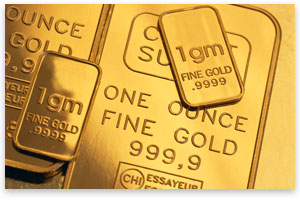Valuation riddle for the yellow metal
By Edward Chancellor
Published: January 9 2011 09:44
Gold is a glittering courtesan of the investment world, making different and even contradictory promises at every turn. At times, it behaves like any other speculative investment. On other occasions, gold offers protection against financial Armageddon. It is widely believed that gold will protect investors against both deflation and inflation. Today, gold is beloved by hedge fund titans and hordes of retail investors, by bulls and bears alike. There’s a catch: none of gold’s many admirers know how to value it.
If a bubble could be identified by popularity, then gold is in a bubble. Harrods, the Knightsbridge department store, now sells bullion over the counter. There are even gold vending machines.
Breaks on Bubblevision, aka CNBC, are filled with ads for gold promoters. Retail investors pile into the exchange traded funds, while some of the most respected institutional investors take delivery of bullion.
The price of gold is buoyed by demand from emerging markets. The Industrial and Commercial Bank of China’s recently launched “Gold Accumulation Plan” has attracted more than a million accounts. “After opening an account,” reports the World Gold Council, Asia’s modern Croesuses “can start to accumulate gold on a daily basis . . . ”
A decade ago, when gold languished below $300 an ounce, it was ignored by the brokers. After a fourfold rise, Wall Street is extrapolating recent price appreciation into the distant future. Goldman has a target $1,690 an ounce for 2011, some 20 per cent above the current price. HSBC forecasts gold will rise by 8 per cent annually for the rest of the decade and recommends a 15 per cent investment allocation to the precious metal. With the euro in trouble and the dollar threatened by Ben Bernanke’s well-oiled printing press, gold has become the hottest “currency”.
Bubbles, however, are defined by valuation rather than investors’ behaviour. Over long periods, the valuation of gold in inflation-adjusted dollars has been stable. Since 1900 gold has averaged $440 in 2010 dollars. By this measure, gold at about $1,400 an ounce is 2.5 standard deviations above its long-run average. Gold is also expensive relative to its cost of extraction, which Credit Suisse estimates at roughly $600 an ounce.
Gold looks overvalued by more traditional yardsticks. In Babylonian times, it was said that an ounce of gold bought some 350 loaves of bread. The wholewheat loaf in my bread bin cost $2.45, which suggests a fair price for gold of about $850.
Another rule-of-thumb says an ounce of gold should purchase a gentleman’s suit. It is not clear what quality of tailoring is suggested. However, Gieves & Hawkes of Savile Row currently offers a navy single-breasted herringbone suit for £795 ($1,224).
Gold looks less pricey compared with other commodities. Since 1900, an ounce of gold has on average purchased 50 times its weight in silver. After last year’s run-up of silver, this ratio has fallen to 47 times. The price of gold in terms of oil has also been pretty constant. Since 1900, an ounce of gold has purchased on average 13.4 barrels of oil. Today, the same ounce buys 15.5 barrels.
There is no scientific method for valuing gold. As Jim Grant observes in his latest newsletter: “You can’t value a non-earning asset, even if you can pretend to.” Mr Grant suggests valuing gold by “1/n, where ‘n’ is the world’s confidence in paper currencies and the mandarins who manipulate them. Regrettably, ‘n’ is unknown.”
Wall Street’s gold bugs make even less effort to identify value. They merely point to the fact that gold has tended to rise when interest rates have been negative. What they fail to mention is that the gold bubble of 1980 collapsed rapidly after Fed chairman Paul Volcker started raising rates. Over the following two years, the gold price fell by two-thirds. The question of valuation, however tricky, should not be ignored. Gold needs to fall by nearly 70 per cent to reach its long-term average price in inflation-adjusted dollars. To come back in line with its cost of production, the gold price would have to decline by about 55 per cent. Relative to the price of bread, gold is about 40 per cent overvalued and relative to oil it is 9 per cent expensive.
Only in terms of silver does gold appear somewhat cheap. The bulls hope that in real terms gold can regain its 1980 bubble peak, which would provide an upside of more than 70 per cent. But the average of our crude valuation metrics suggests a fair value for gold of less than $1,000 an ounce, about a third below the current price.
This is not to say gold will not rise over the coming year or that there is no need to hedge inflation risks. Rather that prudent investors should look to other, less meretricious, assets to protect the purchasing power of their savings.
Edward Chancellor is a member of the asset allocation team at investment manager GMO
Copyright The Financial Times Limited 2011
Home
»
Gold
» VALUATION RIDDLE FOR THE YELLOW METAL / THE FINANCIAL TIMES ( VERY HIGHLY RECOMMENDED READING )
martes, 11 de enero de 2011
Suscribirse a:
Enviar comentarios (Atom)

0 comments:
Publicar un comentario